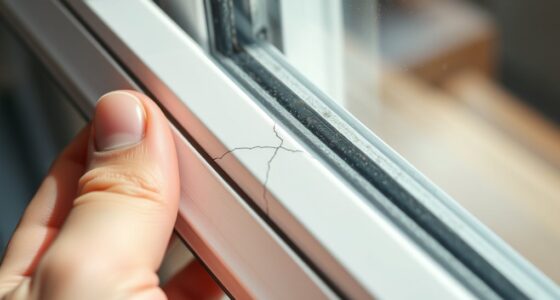To index your gears for crisp shifts, start by ensuring your derailleur is properly aligned parallel to the cassette cogs and your hanger isn’t bent. Use the barrel adjuster to fine-tune cable tension, making shifts smooth and precise. Check that the derailleur moves freely and is well-lubricated without attracting dirt. Regularly inspect and clean components, and make small adjustments as needed. Keep going, and you’ll discover how to master perfect gear changes every time.
Key Takeaways
- Regularly lubricate derailleur pivot points and cable housing to ensure smooth shifting.
- Check and straighten the derailleur hanger for proper alignment with the cassette.
- Use barrel adjusters to fine-tune cable tension for precise gear indexing.
- Inspect and clean the derailleur and chain to remove dirt and prevent shifting issues.
- Replace worn cables and components promptly to maintain optimal gear performance.

Have you ever experienced a sluggish or missed gear shift? If so, you’re not alone. Often, the cause comes down to how well your gears are indexed, which directly impacts how smoothly your bike shifts. One of the first steps to ensuring crisp, reliable gear changes is to pay attention to gear lubrication. Proper lubrication keeps your derailleur moving freely, preventing stiffness or sticking that can cause missed shifts. Use a light bike-specific oil on the derailleur pivot points and the cable housing to reduce friction. Avoid over-lubricating, which can attract dirt and grime, making your shifting less responsive over time. Regularly check and clean your derailleur to keep everything running smoothly; a well-lubricated derailleur is less likely to skip gears or shift hesitantly.
Next, you want to focus on derailleur alignment. Misaligned derailleurs are a common culprit behind poor shifting performance. To check this, shift into the highest gear and visually inspect the derailleur’s position relative to the sprockets. The derailleur cage should be parallel to the cassette cogs. If it’s crooked, your shifting will suffer, and you might notice that the chain doesn’t sit properly on the gears. You can usually adjust the derailleur hanger, which is the part that holds the derailleur in place, by gently bending it back into alignment with a derailleur hanger tool. Make sure you do this carefully to avoid damaging the hanger. Once aligned, you’ll find that your shifts become more precise and reliable.
After addressing lubrication and alignment, it’s time to fine-tune your gear indexing. This involves adjusting the barrels or limit screws so the derailleur moves precisely between gears without overshooting or dropping gears. Shift through all the gears and listen for smooth, crisp transitions. If the chain hesitates or jumps, make small adjustments to the barrel adjuster—turn it clockwise or counterclockwise—to fine-tune the cable tension. Proper tension ensures that the derailleur moves exactly the right distance for each gear change. Remember, these adjustments may require a bit of trial and error, but patience pays off when you get that perfect, crisp shift every time.
Frequently Asked Questions
How Often Should I Reindex My Gears?
You should reindex your gears whenever you notice sluggish or missed shifts, typically every few months or after riding in rough conditions. Regular gear lubrication helps prevent gear wear and keeps shifting smooth. If you experience difficulty shifting or gear slippage, reindex immediately. Keeping your gears properly indexed ensures peak performance, reduces wear over time, and minimizes the need for costly repairs. Stay attentive to shifting issues, and reindex as needed for smooth rides.
Can I Index Gears Myself or Need a Professional?
Did you know that nearly 60% of cyclists prefer DIY adjustments for minor gear issues? You can definitely catalog your gears yourself with a little patience and some guidance, but for precision and safety, a professional service is often best. If you’re comfortable with bike repairs, a DIY adjustment can save money. However, if you’re unsure or uncomfortable, it’s wise to seek a professional to ensure perfect, crisp shifts every time.
What Tools Are Required for Gear Indexing?
You’ll need a bike-specific gear alignment tool or a Phillips screwdriver to adjust the derailleur. Also, have a cable tension gauge or feel for proper tension to guarantee smooth shifting. First, loosen the cable, then shift through all gears to check alignment. Fine-tune the cable tension and derailleur position until shifts are crisp. With patience, you can do this yourself, but a professional can help if you encounter issues.
How Do Weather Conditions Affect Gear Shifting?
Ever felt your gears slip when the weather turns? Weather impact can be significant, affecting gear performance and shifting smoothness. Cold temperatures cause lubricants to thicken, making shifts stiff and sluggish. Humidity and rain introduce moisture, leading to rust and corrosion that hinder gear movement. You need to regularly check and adjust your gears, especially in extreme weather, to keep shifting crisp and reliable. Don’t let weather dictate your ride’s quality—stay prepared.
What Are Signs of Improperly Indexed Gears?
You’ll notice improper gear indexing when shifts feel rough or don’t align correctly with the gear you select. If your gear alignment is off, the chain might skip or hesitate, especially under load. Check your cable tension; too loose or too tight cables can cause shifting issues. Regularly inspecting and adjusting these guarantees your gears shift smoothly and stay properly aligned, preventing further problems.
Conclusion
By properly indexing your gears, you guarantee smooth, crisp shifts every time. Imagine you’re racing on a mountain trail, and your bike shifts seamlessly as you navigate tricky turns—no hesitation, just control. That’s the power of well-aimed indexing. Take a moment to check your derailleur alignment and cable tension regularly. With a little effort, you’ll enjoy precise shifts, boosting your confidence and ride quality on every adventure.







